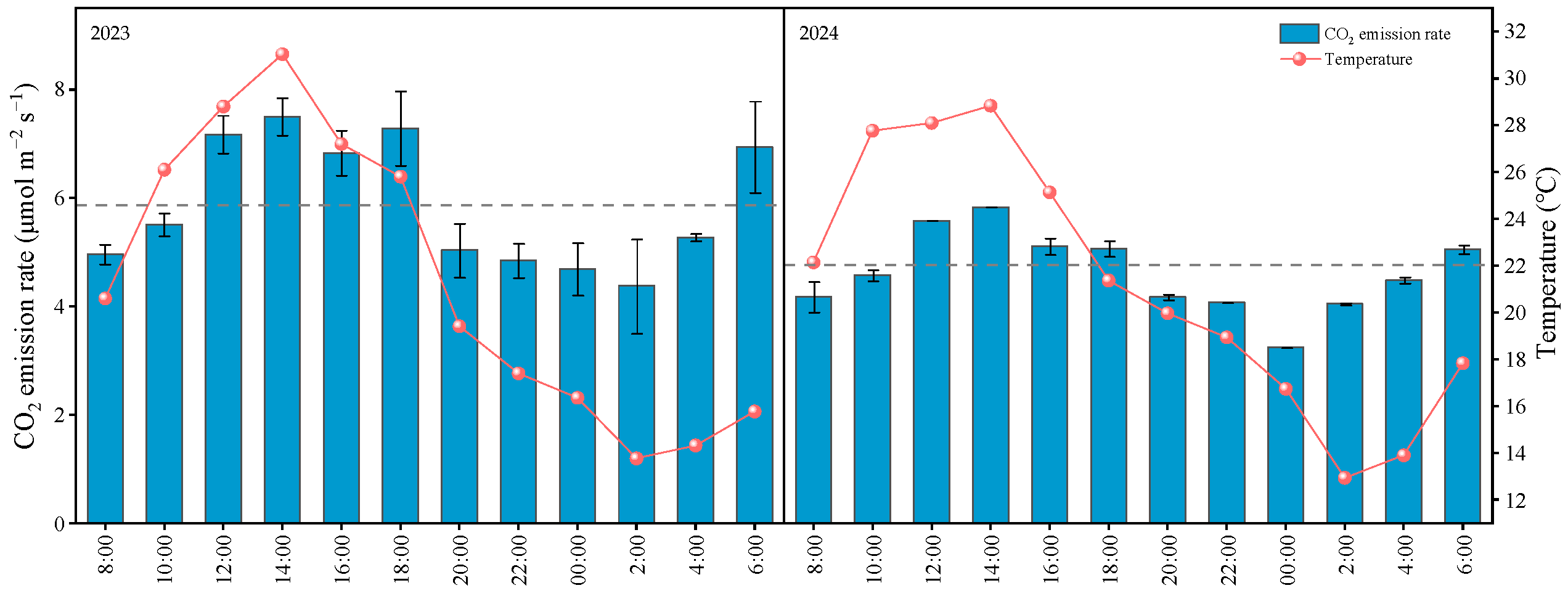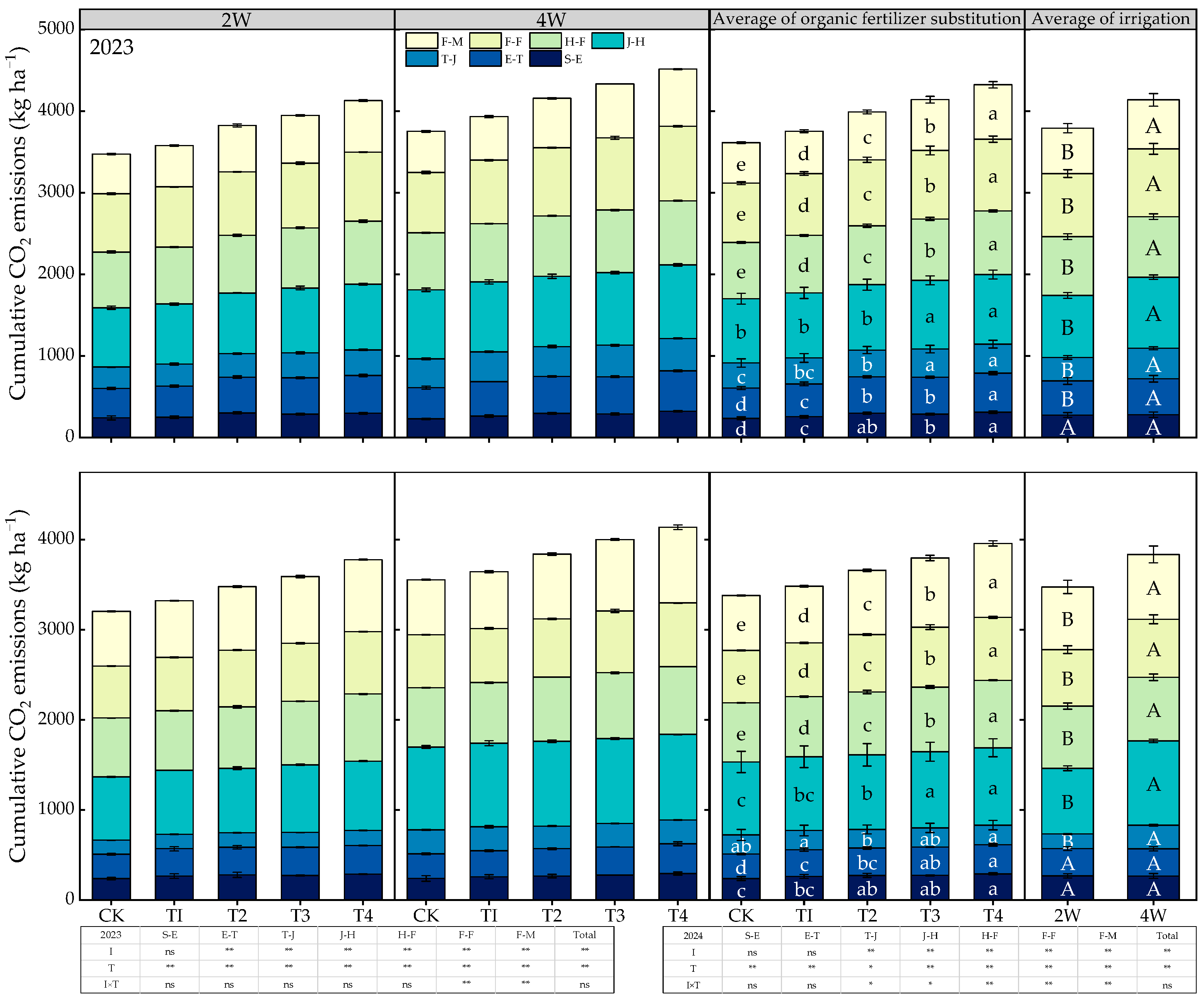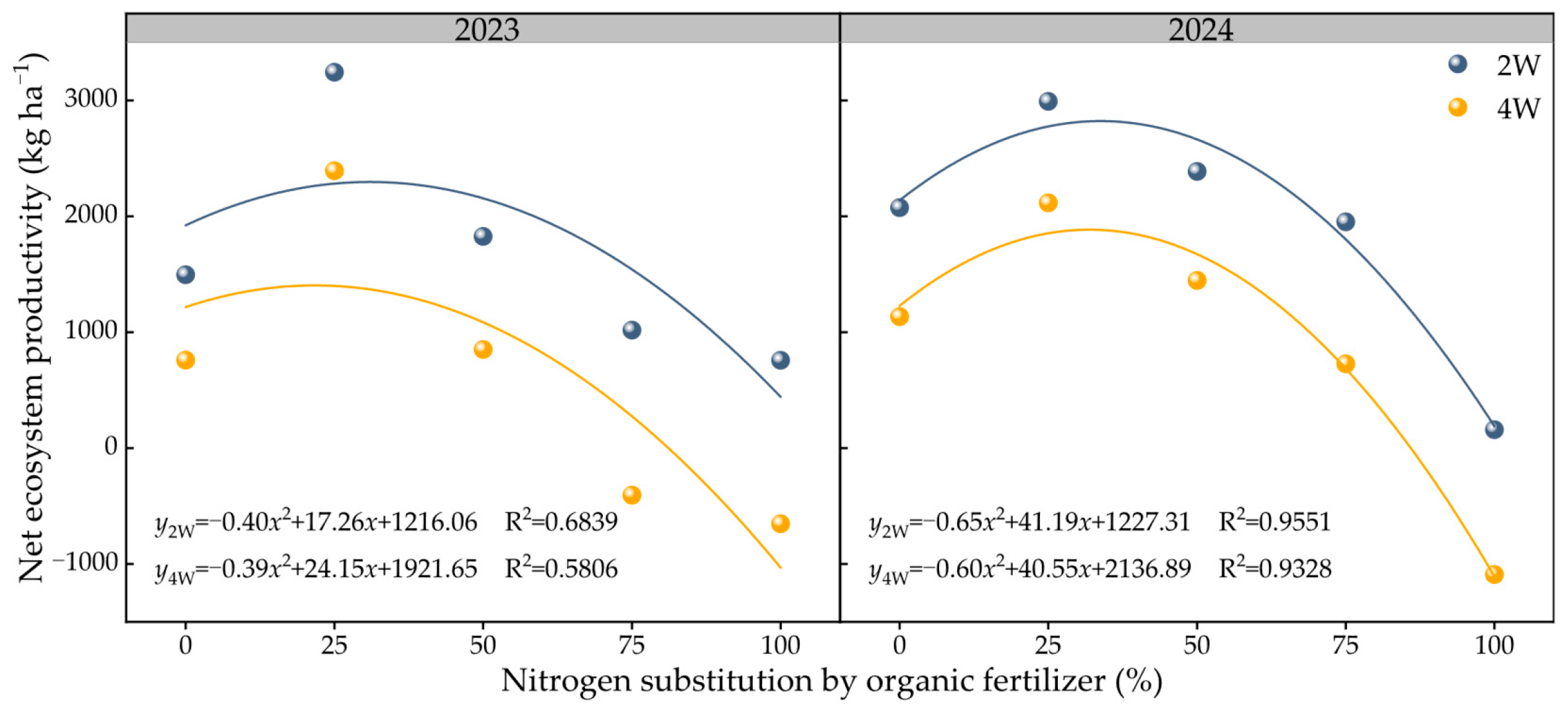Effects of Organic Fertilizer Substitution for Chemical Fertilizer Nitrogen and Limited Irrigation on Soil Carbon Emissions in Spring Wheat Fields
Abstract
1. Introduction
2. Results
2.1. Diurnal Changes in Soil CO2 Emission Rates
2.2. Seasonal Changes in Soil CO2 Emission Rates
2.3. Differences in Cumulative Soil CO2 Emissions
2.4. Correlation Between Soil Properties and CO2 Emission Rates
2.5. Differences in Carbon Footprint Composition
2.6. Relationship Between NEP and Substitution
3. Discussion
4. Materials and Methods
4.1. Experiment Site
4.2. Experiment Design
4.3. Data Collection
4.3.1. Soil Respiration Measurements and Analysis
4.3.2. Determination of Soil Properties
4.4. Data Calculation
4.4.1. Cumulative Soil CO2 Emissions
4.4.2. Carbon Footprint of Wheat Production
4.5. Data Statistical Analysis
5. Conclusions
Author Contributions
Funding
Data Availability Statement
Conflicts of Interest
References
- Li, Z.; Zhang, Q.; Li, Z.; Qiao, Y.F.; Du, K.; Yue, Z.W.; Tian, C.; Leng, P.F.; Cheng, H.F.; Chen, G.; et al. Responses of soil CO2 emissions to tillage practices in a wheat maize cropping system: A 4-year field study. Field Crop. Res. 2023, 294, 108832. [Google Scholar] [CrossRef]
- Raich, J.W.; Schlesinger, W.H. The global carbon dioxide flux in soil respiration and its relationship to vegetation and climate. Tellus B 1992, 44, 81–99. [Google Scholar] [CrossRef]
- Zhang, S.; Chen, W.; Wang, Y.; Shi, H.M.; Sun, Z.X.; Zhu, B.R.; Seyoum, G. Human interventions have enhanced the net ecosystem productivity of farmland in China. Nat. Commun. 2024, 15, 10523. [Google Scholar] [CrossRef]
- Hossain, M.E.; Islam, M.S.; Sujan, M.H.K.; Tuhin, M.M.U.J.; Bekun, F.V. Towards a clean production by exploring the nexus between agricultural ecosystem and environmental degradation using novel dynamic ARDL simulations approach. Environ. Sci. Pollut. Res. 2022, 29, 53768–53784. [Google Scholar] [CrossRef]
- Thangarajan, R.; Bolan, N.S.; Tian, G.L.; Naidu, R.; Kunhikrishnan, A. Role of organic amendment application on greenhouse gas emission from soil. Sci. Total Environ. 2013, 465, 72–96. [Google Scholar] [CrossRef]
- Hou, H.J.; Han, Z.D.; Yang, Y.Q.; Abudu, S.; Cai, H.J.; Li, Z.C. Soil CO2 emissions from summer maize fields under deficit irrigation. Environ. Sci. Pollut. Res. 2020, 27, 4442–4449. [Google Scholar] [CrossRef]
- Rahman, F.; Rahman, M.M.; Rahman, G.M.; Saleque, M.A.; Hossain, A.S.; Miah, M.G. Effect of organic and inorganic fertilizers and rice straw on carbon sequestration and soil fertility under a rice–rice cropping pattern. Carbon Manag. 2016, 7, 41–53. [Google Scholar] [CrossRef]
- Wei, Q.; Xu, J.Z.; Yang, S.H.; Liao, L.X.; Jin, G.Q.; Li, Y.W.; Hameed, F. Subsurface watering resulted in reduced soil N2O and CO2 emissions and their global warming potentials than surface watering. Atmos. Environ. 2018, 173, 248–255. [Google Scholar] [CrossRef]
- Chen, S.T.; Zou, J.W.; Hu, Z.H. Measurements and Modeling of Soil Respiration in Terrestrial Ecosystems. Ecol. Environ. Sci. 2017, 26, 1985–1996. [Google Scholar]
- Bekku, Y.; Koizumi, H.; Oikawa, T.; Iwaji, H. Examination of four methods for measuring soil respiration. Appl. Soil Ecol. 1997, 5, 247–254. [Google Scholar] [CrossRef]
- Tang, X.L.; Liu, S.G.; Zhou, G.Y.; Zhang, D.Q.; Zhou, G.Y. Soil—Atmospheric exchange of CO2, CH4, and N2O in three subtropical forest ecosystems in southern China. Glob. Change Biol. 2006, 12, 546–560. [Google Scholar] [CrossRef]
- Rochette, P.; Gregorich, E.G.; Desjardins, R.L. Comparison of static and dynamic closed chambers for measurement of soil respiration under field conditions. Can. J. Soil Sci. 1992, 72, 605–609. [Google Scholar] [CrossRef]
- Nakadai, T.; Koizumi, H.; Usami, Y.; Satoh, M.; Oikawa, T. Examination of the method for measuring soil respiration in cultivated land: Effect of carbon dioxide concentration on soil respiration. Ecol. Res. 1993, 8, 65–71. [Google Scholar] [CrossRef]
- Bond-Lamberty, B.; Thomson, A. A global database of soil respiration data. Biogeosciences 2010, 7, 1915–1926. [Google Scholar] [CrossRef]
- Zhao, C.X.; Qiu, R.J.; Zhang, T.; Luo, Y.F.; Agathokleous, E. Effects of Alternate Wetting and Drying Irrigation on Methane and Nitrous Oxide Emissions from Rice Fields: A Meta-Analysis. Glob. Change Biol. 2024, 30, e17581. [Google Scholar] [CrossRef]
- Ariani, M.; Hanudin, E.; Haryono, E. The effect of contrasting soil textures on the efficiency of alternate wetting-drying to reduce water use and global warming potential. Agric. Water Manag. 2022, 274, 107970. [Google Scholar] [CrossRef]
- Liu, S.; Wang, X.Q.; Hu, J.P.; Li, Q.; Cui, L.L.; Duan, X.Q.; Guo, L. Effects of Fertilization and Irrigation on the Carbon Footprint of Alfalfa in Gansu Province. Sci. Agric. Sin. 2018, 51, 556–565. [Google Scholar]
- Fan, Y.; Zhao, X.F.; Me, T.; Wu, Z.H.; Chen, S.P.; Liu, X.G. Nitrogen Emissions and Carbon Footprint Analysis of Chemical Fertilizer Input in Wheat Production System in Hebei Province. Henan Sci. 2024, 42, 789–796. [Google Scholar]
- Abdo, A.I.; Sun, D.L.; Yang, K.; Li, Y.Z.; Shi, Z.J.; Allgh, W.E.; Sobky, E.A.; Wei, H.; Zhang, J.E.; Kuzyakov, Y. Carbon footprint of synthetic nitrogen under staple crops: A first cradle-to-grave analysis. Glob. Change Biol. 2024, 30, e17277. [Google Scholar] [CrossRef]
- Ali, S.; Xu, Y.Y.; Jia, Q.M.; Ahmad, I.; Ma, X.C.; Yan, Z.; Cai, T.; Ren, X.L.; Zhang, P.; Jia, Z.K. Interactive effects of planting models with limited irrigation on soil water, temperature, respiration and winter wheat production under simulated rainfall conditions. Agric. Water Manag. 2018, 204, 198–211. [Google Scholar] [CrossRef]
- Zhong, Y.X.; Li, J.Z.; Xiong, L. Effect of deficit irrigation on soil CO2 and N2O emissions and winter wheat yield. J. Clean. Prod. 2021, 279, 123718. [Google Scholar] [CrossRef]
- Sainju, U.M.; Jabro, J.D.; Stevens, W.B. Soil carbon dioxide emission and carbon content as affected by irrigation, tillage, cropping system, and nitrogen fertilization. J. Environ. Qual. 2008, 37, 98–106. [Google Scholar] [CrossRef]
- Jia, X.Y.; Yan, W.M.; Ma, H.Z.; Shangguan, Z.P. Antagonistic and synergistic interactions dominate GHGs fluxes, soil properties and yield responses to biochar and N addition. Front. Environ. Sci. 2023, 11, 1123897. [Google Scholar] [CrossRef]
- Hammond, G. Time to give due weight to the ‘carbon footprint ‘issue. Nature 2007, 445, 256. [Google Scholar] [CrossRef]
- Cao, Y.Q.; Qi, F.L.; Cui, H.Y.; Yuan, M. Knowledge domain and emerging trends of carbon footprint in the field of climate change and energy use: A bibliometric analysis. Environ. Sci. Pollut. Res. 2023, 30, 35853–35870. [Google Scholar] [CrossRef]
- Ji, J.P.; Ma, X.M. Review of Carbon Footprint: Definitions and Accounting Methods. Ecol. Econ. 2011, 27, 76–80. [Google Scholar]
- Kamran, M.; Yan, Z.G.; Chang, S.H.; Chen, X.J.; Ahmad, I.; Jia, Q.M.; Ghani, M.U.; Nouman, M.; Hou, F.J. Enhancing resource use efficiency of alfalfa with appropriate irrigation and fertilization strategy mitigate greenhouse gases emissions in the arid region of Northwest China. Field Crops Res. 2022, 289, 108715. [Google Scholar] [CrossRef]
- Abalos, D.; Sanchez, M.L.; Garcia, T.L.; Groenigen, K.W.; Vallejo, A. Management of irrigation frequency and nitrogen fertilization to mitigate GHG and NO emissions from drip-fertigated crops. Sci. Total Environ. 2014, 490, 880–888. [Google Scholar] [CrossRef]
- Xing, S.L.; Wang, J.X.; Yang, J.F.; Huang, S.H.; Nie, H.L.; Zhang, J.; Yang, H.M.; Yang, W.F.; Yang, Y.M.; Wang, L.; et al. Effects of fertilizer management on wheat yield, carbon and nitrogen footprint under drip irrigation. Trans. Chin. Soc. Agric. Eng. 2025, 41, 103–111. [Google Scholar]
- Liu, J.J.; Zhang, A.F.; Feng, H.; Zou, X.Y.; Chen, H.X. Influences of different irrigation amounts on carbon sequestration in wheat-maize rotation system. Chin. J. Appl. Ecol. 2017, 28, 169–179. [Google Scholar]
- Wang, L.; Wang, E.L.; Chen, G.Q.; Qian, X.; Liu, Q.; Gao, Y.B.; Zhang, H.; Liu, K.C.; Li, Z.X. Optimizing straw return to enhance grain production and approach carbon neutrality in the intensive cropping systems. Soil Tillage Res. 2025, 248, 106447. [Google Scholar] [CrossRef]
- Li, R.N.; Li, Y.E.; Wang, B.; Wan, Y.F.; Li, J.L.; Ma, P.; Wen, S.M.; Qin, X.B.; Gao, Z.Q. Pattern selection of water and nitrogen practices to reduce greenhouse gas emission and increase profit in a double rice system. Trans. Chin. Soc. Agric. Eng. 2020, 36, 105–113. [Google Scholar]
- Baltrenas, P.; Pranskevičius, M.; Lietuvninkas, A. Investigation and evaluation of carbon dioxide emissions from soil in Neris Regional Park. J. Environ. Eng. Landsc. Manag. 2011, 19, 115–122. [Google Scholar] [CrossRef]
- Klimek, K.A.; Sadowska, U.; Kuboń, M.; Gliniak, M.; Sikora, J. Sunflower Husk Biochar as a Key Agrotechnical Factor Enhancing Sustainable Soybean Production. Agriculture 2021, 11, 305. [Google Scholar] [CrossRef]
- Li, X.L.; He, T.Q.; Zhang, C.X.; Tian, M.H.; Wu, M.; Li, C.H.; Yang, Q.H.; Zhang, X.L. Effect of Organic Fertilizer Replacing Chemical Fertilizers on Greenhouse Gas Emission Under the Conditions of Same Nitrogen Fertilizer Input in Maize Farmland. Sci. Agric. Sin. 2022, 55, 948–961. [Google Scholar]
- Li, X.Y.; Li, J.; Bi, R.X.; Jin, X.X.; Fan, Q.F.; Zou, H.T. Effects of Corn Straw Concentrated Deep Returning on Soil CO2 Emission in Dry Land. Soils 2024, 56, 1027–1033. [Google Scholar]
- Liu, X.H.; Xu, X.W.; Li, Z.J.; Chu, Q.Q.; Yang, X.L. The missteps, improvement and application of carbon footprint methodology in farmland ecosystems with the case study of analyzing the carbon efficiency of China’s intensive farming. Chin. J. Agric. Resour. Reg. Plan. 2013, 34, 1–11. [Google Scholar]
- Liu, X.L.; Wang, H.T.; Chen, J.; He, Q.; Zhang, H.; Jiang, R.; Chen, X.X.; Hou, P. Method and basic model for development of Chinese reference life cycle database. Acta Sci. Circumstantiae 2010, 30, 2136–2144. [Google Scholar]
- Ecoinventv Database. Available online: https://ecoinvent.org/ (accessed on 14 February 2025).





| Year | Soil Properties | SO | EM | TI | JO | HE | FL | FI | MA |
|---|---|---|---|---|---|---|---|---|---|
| 2023 | Temperature in 10 cm (°C) | 0.125 | 0.419 | 0.657 * | 0.693 * | 0.742 * | 0.815 ** | 0.961 ** | 0.728 * |
| Temperature in 20 cm (°C) | 0.106 | 0.372 | 0.401 | 0.610 * | 0.684 * | 0.897 ** | 0.816 ** | 0.701 * | |
| Water content in 10 cm (%) | 0.071 | 0.612 * | 0.764 * | 0.673 * | 0.750 * | 0.805 ** | 0.741 * | 0.629 * | |
| Compactness in 20 cm (Pa) | 0.174 | 0.107 | 0.282 | 0.315 | 0.275 | 0.324 | 0.328 | 0.231 | |
| Compactness in 40 cm (Pa) | 0.221 | 0.197 | 0.348 | 0.486 | 0.425 | 0.298 | 0.352 | 0.429 | |
| pH value in 20 cm | 0.227 | 0.306 | 0.247 | 0.193 | 0.159 | 0.208 | 0.125 | 0.302 | |
| 2024 | Temperature in 10 cm (°C) | −0.590 | 0.020 | 0.284 | 0.650 ** | 0.365 * | 0.494 ** | 0.368 * | 0.450 * |
| Temperature in 20 cm (°C) | −0.265 | −0.340 | 0.298 | 0.391 * | 0.365 * | 0.518 * | 0.485 ** | 0.419 * | |
| Water content in 10 cm (%) | 0.010 | 0.349 | 0.320 | 0.972 ** | 0.363 * | 0.364 * | 0.361 * | 0.418 * | |
| Compactness in 20 cm (Pa) | 0.320 | 0.011 | 0.018 | 0.336 | 0.028 | 0.003 | 0.025 | 0.339 | |
| Compactness in 40 cm (Pa) | 0.251 | 0.022 | 0.358 | 0.057 | 0.090 | 0.046 | 0.107 | 0.110 | |
| pH value in 20 cm | 0.275 | 0.277 | 0.150 | 0.085 | 0.182 | 0.123 | 0.165 | 0.022 |
| Years | Treatment | Agricultural Production Materials CO2 Emissions | Soil Emissions | Total Emissions | Total Absorption | CO2 Budget NEP | |||||
|---|---|---|---|---|---|---|---|---|---|---|---|
| Seeds | CF | OF | IG | FM | PT | ||||||
| 2023 | 2WCK | 239.3 | 1307.3 | 0 | 1107.0 | 26.6 | 15.2 | 3474.5 | 6169.9 | 7665.5 c | −1495.6 |
| 2WT1 | 239.3 | 1163.8 | 66.8 | 1107.0 | 26.6 | 15.2 | 3578.5 | 6197.2 | 9440.7 a | −3243.5 | |
| 2WT2 | 239.3 | 1020.4 | 133.5 | 1107.0 | 26.6 | 15.2 | 3824.4 | 6366.4 | 8193.1 b | −1826.7 | |
| 2WT3 | 239.3 | 876.9 | 200.3 | 1107.0 | 26.6 | 15.2 | 3946.2 | 6411.5 | 7429.7 d | −1018.2 | |
| 2WT4 | 239.3 | 733.5 | 267.0 | 1107.0 | 26.6 | 15.2 | 4128.0 | 6516.6 | 7274.5 e | −757.9 | |
| 4WCK | 239.3 | 1307.3 | 0 | 2214.0 | 26.6 | 15.2 | 3752.4 | 7554.8 | 8313.1 b | −758.3 | |
| 4WT1 | 239.3 | 1163.8 | 66.8 | 2214.0 | 26.6 | 15.2 | 3930.5 | 7656.2 | 10049.0 a | −2392.8 | |
| 4WT2 | 239.3 | 1020.4 | 133.5 | 2214.0 | 26.6 | 15.2 | 4154.9 | 7803.9 | 8654.5 b | −850.6 | |
| 4WT3 | 239.3 | 876.9 | 200.3 | 2214.0 | 26.6 | 15.2 | 4331.7 | 7904.0 | 7497.9 c | 406.1 | |
| 4WT4 | 239.3 | 733.5 | 267.0 | 2214.0 | 26.6 | 15.2 | 4512.6 | 8008.2 | 7355.2 c | 653.0 | |
| 2024 | 2WCK | 239.3 | 1307.3 | 0 | 1107.0 | 26.6 | 15.2 | 3204.7 | 5900.1 | 7974.4 c | −2074.3 |
| 2WT1 | 239.3 | 1163.8 | 66.8 | 1107.0 | 26.6 | 15.2 | 3323.2 | 5941.9 | 8934.5 a | −2992.6 | |
| 2WT2 | 239.3 | 1020.4 | 133.5 | 1107.0 | 26.6 | 15.2 | 3478.5 | 6020.5 | 8407.6 b | −2387.1 | |
| 2WT3 | 239.3 | 876.9 | 200.3 | 1107.0 | 26.6 | 15.2 | 3590.8 | 6056.1 | 8008.0 c | −1951.9 | |
| 2WT4 | 239.3 | 733.5 | 267.0 | 1107.0 | 26.6 | 15.2 | 3778.8 | 6167.4 | 6325.8 d | −158.4 | |
| 4WCK | 239.3 | 1307.3 | 0 | 2214.0 | 26.6 | 15.2 | 3555.0 | 7357.4 | 8491.6 c | −1134.2 | |
| 4WT1 | 239.3 | 1163.8 | 66.8 | 2214.0 | 26.6 | 15.2 | 3645.0 | 7370.7 | 9486.3 a | −2115.6 | |
| 4WT2 | 239.3 | 1020.4 | 133.5 | 2214.0 | 26.6 | 15.2 | 3840.2 | 7489.2 | 8935.1 b | −1445.9 | |
| 4WT3 | 239.3 | 876.9 | 200.3 | 2214.0 | 26.6 | 15.2 | 4002.4 | 7574.7 | 8301.0 c | −726.3 | |
| 4WT4 | 239.3 | 733.5 | 267.0 | 2214.0 | 26.6 | 15.2 | 4138.5 | 7634.1 | 6542.3 d | 1091.8 | |
| Treatment Code | Starter Fertilizer | Top Dressing Urea (45% N) | |
|---|---|---|---|
| Organic Fertilizer | Diammonium Phos-Phate (18% N, 46% P2O5) | ||
| 2WCK | 0 | 450 | 375.00 |
| 2WT1 | 750 | 450 | 281.25 |
| 2WT2 | 1500 | 450 | 187.50 |
| 2WT3 | 2250 | 450 | 93.75 |
| 2WT4 | 3000 | 450 | 0 |
| 4WCK | 0 | 450 | 375.00 |
| 4WT1 | 750 | 450 | 281.25 |
| 4WT2 | 1500 | 450 | 187.50 |
| 4WT3 | 2250 | 450 | 93.75 |
| 4WT4 | 3000 | 450 | 0 |
| Input Item | Emission Factor | Data Source |
|---|---|---|
| Nitrogen Fertilizer | 1.53 kg kg−1 | CLCD v0.8 database [38] |
| Phosphate Fertilizer | 1.63 kg kg−1 | CLCD v0.8 database |
| Potash Fertilizer | 0.65 kg kg−1 | CLCD v0.8 database |
| Organic Fertilizer | 0.089 kg kg−1 | CLCD v0.8 database |
| Herbicide | 10.15 kg kg−1 | Ecoinventv2.2 database [39] |
| Diesel Fuel | 0.59 kg kg−1 | IPCC Guidelines |
| Electricity | 0.82 kg (kw h)−1 | CLCD v0.8 database |
| Wheat Seeds | 0.58 kg kg−1 | Ecoinventv3.1 database [39] |
Disclaimer/Publisher’s Note: The statements, opinions and data contained in all publications are solely those of the individual author(s) and contributor(s) and not of MDPI and/or the editor(s). MDPI and/or the editor(s) disclaim responsibility for any injury to people or property resulting from any ideas, methods, instructions or products referred to in the content. |
© 2025 by the authors. Licensee MDPI, Basel, Switzerland. This article is an open access article distributed under the terms and conditions of the Creative Commons Attribution (CC BY) license (https://creativecommons.org/licenses/by/4.0/).
Share and Cite
Luo, J.; Xie, M.; Zhao, Z.; Ren, X.; Li, M.; Zhang, Y. Effects of Organic Fertilizer Substitution for Chemical Fertilizer Nitrogen and Limited Irrigation on Soil Carbon Emissions in Spring Wheat Fields. Plants 2025, 14, 3382. https://doi.org/10.3390/plants14213382
Luo J, Xie M, Zhao Z, Ren X, Li M, Zhang Y. Effects of Organic Fertilizer Substitution for Chemical Fertilizer Nitrogen and Limited Irrigation on Soil Carbon Emissions in Spring Wheat Fields. Plants. 2025; 14(21):3382. https://doi.org/10.3390/plants14213382
Chicago/Turabian StyleLuo, Jun, Min Xie, Zhiwei Zhao, Xiuzhen Ren, Mengyuan Li, and Yongping Zhang. 2025. "Effects of Organic Fertilizer Substitution for Chemical Fertilizer Nitrogen and Limited Irrigation on Soil Carbon Emissions in Spring Wheat Fields" Plants 14, no. 21: 3382. https://doi.org/10.3390/plants14213382
APA StyleLuo, J., Xie, M., Zhao, Z., Ren, X., Li, M., & Zhang, Y. (2025). Effects of Organic Fertilizer Substitution for Chemical Fertilizer Nitrogen and Limited Irrigation on Soil Carbon Emissions in Spring Wheat Fields. Plants, 14(21), 3382. https://doi.org/10.3390/plants14213382




